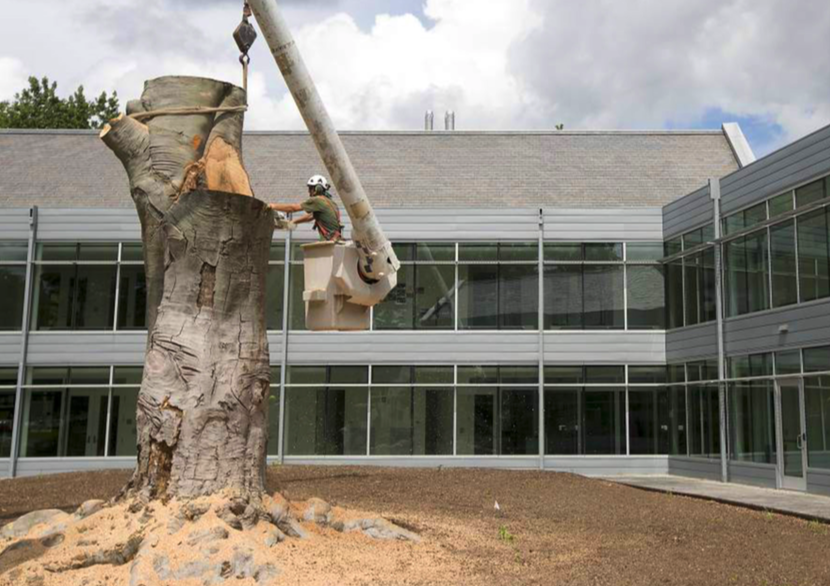
The beech tree outside the Lanphier Center was cut down during the summer while students were away from campus.
As returning students walked around campus during their first few days back, they noticed a drastic physical change: the absence of the Copper Beech tree that was the focal point of the Lanphier Center courtyard. Four years ago, the Lanphier Center was designed around the tree, and the building looks very different without the tree’s immense presence in the courtyard. The tree’s trunk was rotting through, and, despite an extensive effort to save the it, the tree had to be cut down the past summer.
It is not known whether or not the construction of the Lanphier Center contributed to the tree’s death. Mr. Joe Scanio, Program Director at the Kohler Environmental Center (KEC), said, “It was not a tree that they thought was likely to die before the construction started; otherwise, they wouldn’t have left it in the first place. It wasn’t showing signs of imminent death before the construction, so whether or not there might be something that wasn’t obvious, that’s a different question, but certainly, that kind of disturbance has a decent probability of killing the tree.”
The roots of the tree were cut before the construction of the Lanphier Center, and, subsequently, there was rotting due to the increased difficulty of the tree being able to gather water and nutrients to support itself. Biology teacher Mr. Derron Chang noted, “When a tree is under stress, it is much more susceptible to disease, and, in this case, it was attacked by some sort of fungus.” It was hoped that the tree could regrow its roots, though when the trunk began losing its structural integrity, there was not anything that could be done to salvage it.
The Copper Beech is native to Europe, found from southern Sweden down to Sicily and from Portugal across to northwest Turkey. Since the 1800s, they’ve been planted for ornamental purposes in the United States. Mr. Chang said that these trees “have been known to last for 200+ years, that is under proper conditions.” For as long as anyone at Choate can recall, the Copper Beech stood in front of the old Head of School’s home before it was demolished to make space for the Lanphier Center.
Choate did everything in its power to preserve the tree. A professional arborist was hired to monitor it and make sure nutrients were provided for the tree throughout the construction phase. The architects intentionally created a space for it and built a retaining wall to protect it. Mr. Scanio said, “Usually there are enough nutrients stored within the tree that it can make it at least a year after construction, but it’s not till the second and third year where you really begin to see if it survived and that’s basically what we saw. It didn’t make it after that initial stage.”
The School is now deciding how the space left by the Copper Beech tree can be best utilized for the community. “One of the things I think that the School, Dr. Curtis, is looking at is how to make that space attractive and usable for the students,” added Mr. Scanio.
There is talk of putting in another tree to replace the Copper Beech, and the benefits of a tree for the Lanphier Center have proven valuable. One of the big advantages of the tree was its benefits for the building’s energy efficiency. In the late spring, summer, and early fall the tree shaded the building. As Mr. Scanio explained, “Without a tree, that makes the building hotter, it makes it use a lot more energy.” In the winter, the tree would lose all of its leaves, allowing sunlight to come through and help warm the building.
The wood from the tree is currently being left to dry out, as the School would like to use the wood to make some sort of furniture, such as benches or tables. The KEC has done exactly this with two wooden tables that were made from a fallen tree by the football field. By using the tree’s wood this way, the legacy of the tree can live on with the school.


